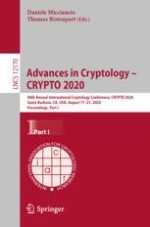2020 | OriginalPaper | Buchkapitel
Adaptively Secure Constrained Pseudorandom Functions in the Standard Model
verfasst von : Alex Davidson, Shuichi Katsumata, Ryo Nishimaki, Shota Yamada, Takashi Yamakawa
Erschienen in: Advances in Cryptology – CRYPTO 2020
Aktivieren Sie unsere intelligente Suche, um passende Fachinhalte oder Patente zu finden.
Wählen Sie Textabschnitte aus um mit Künstlicher Intelligenz passenden Patente zu finden. powered by
Markieren Sie Textabschnitte, um KI-gestützt weitere passende Inhalte zu finden. powered by
Abstract
-
We construct adaptively secure and O(1)-collusion-resistant CPRFs for t-conjunctive normal form (t-CNF) predicates from one-way functions (OWFs) where t is a constant. Here, O(1)-collusion-resistance means that we can allow the adversary to obtain a constant number of constrained keys. Note that t-CNF includes bit-fixing predicates as a special case.
-
We construct adaptively secure and single-key CPRFs for inner-product predicates from the learning with errors (LWE) assumption. Here, single-key security means that we only allow the adversary to learn one constrained key. Note that inner-product predicates include t-CNF predicates for a constant t as a special case. Thus, this construction supports more expressive class of predicates than that supported by the first construction though it loses the collusion-resistance and relies on a stronger assumption.
-
We construct adaptively secure and O(1)-collusion-resistant CPRFs for all circuits from the LWE assumption and indistinguishability obfuscation (IO).
